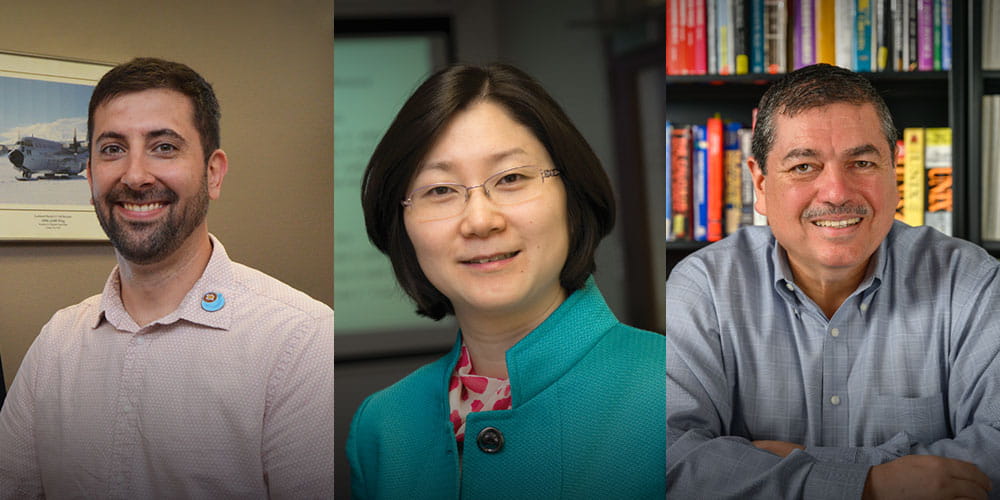NASA establishes UTA as Heliophysics DRIVE Science Center

NASA has selected a team of physicists from The University of Texas at Arlington to investigate how differences in Earth’s northern and southern hemispheres affect the planet’s response to space weather.
UTA’s Daniel Welling, assistant professor of physics, and Yue Deng and Ramon Lopez, professors of physics, are developing advanced computer models that examine space weather to account for Earth’s interhemispheric asymmetries.
The two-year, $1.3 million project establishes UTA as a Heliophysics DRIVE Science Center, a NASA program established to address grand challenge goals that are deemed poised and ready for major advancements. UTA’s proposal was selected as a phase-one project through a very competitive process to determine proof of concept. From there, the team will be up for selection to become a fully funded center in phase two.
“Congratulations to Dan, Yue and Ramon on a terrific accomplishment,” UTA President Vistasp Karbhari said. “This is a tremendous recognition of their scientific leadership and reputation and clearly places UTA among the very best space physics groups in the country. Their work in modeling and data science related to heliophysics has been at the cutting edge, and this phase-one project is another stepping stone toward building even greater levels of international excellence. I’m extremely proud of this team and grateful for the way in which they have integrated tremendous scientific advancement with great student opportunities and mentorship.”
Welling, Deng and Lopez—each with extensive experience in studying space weather—say the challenge with understanding these asymmetries is that computer models are outdated and ignore interhemispheric asymmetry. Using the current models is like “trying to study a round planet with tools that assume it’s flat,” Welling said.
Over the next two years, Welling, Deng, Lopez and their collaborators will run a pilot study to update two well-known computer models in the field, while working with the broader space physics community to build a database of known sources of interhemispheric asymmetry and assess current modeling capabilities.
“Scientists have known for a long time that the Earth’s response to stormy space weather is different in the northern and southern hemispheres,” Welling said. “If you see the aurora borealis and australis, also known as the northern and southern lights, they are often very different, but the space conditions driving these phenomena are the same. We don’t fully understand why that is yet.”
NASA’s DRIVE Science Center program supports science that cannot effectively be done by individual investigators or small teams. It instead requires the synergistic, coordinated efforts of a research center.
The UTA team is joining forces with the University of California-Los Angeles, the Aerospace Corporation and others to revolutionize understanding of the conditions that create space weather.
Other UTA-NASA partnerships include:
- In 2019, Purnendu “Sandy” Dasgupta, Hamish Small Chair in Ion Analysis in the Department of Chemistry and Biochemistry and adjunct professor in the departments of Physics and Electrical Engineering, used over $2 million in funding from NASA to engineer and begin testing a device capable of collecting drops of liquid as it travels through space and analyzing their content for conditions that support life.
- Krishnan Rajeshwar, distinguished professor of chemistry and biochemistry, and Brian Dennis, professor of mechanical and aerospace engineering, worked on a project with NASA funding to improve methods for oxygen recovery and reuse aboard human spacecraft.
- UTA’s Learning Innovation and Networked Knowledge Research Lab worked with Boeing and NASA to better understand the role that social networks play in the completion rates and academic performances of students taking online courses.
- In 2017, Cody Ground, a mechanical and aerospace engineering doctoral student, earned a prestigious Pathways internship with the Hypersonic Air-Breathing Propulsion Branch at NASA Langley Research Center.